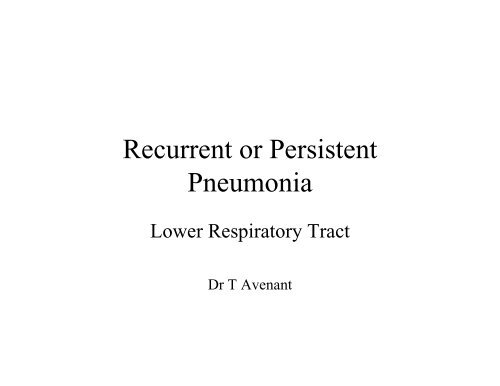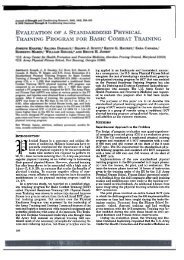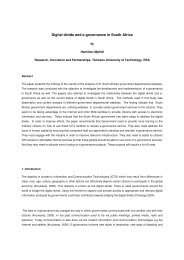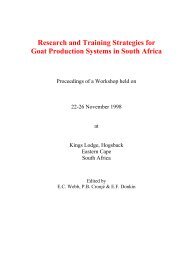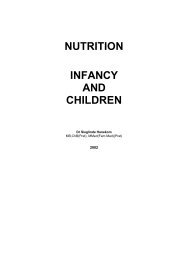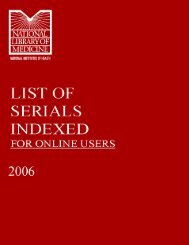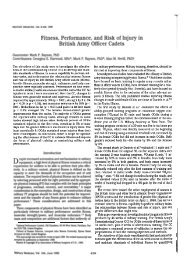Recurrent or Persistent Pneumonia
Recurrent or Persistent Pneumonia
Recurrent or Persistent Pneumonia
Create successful ePaper yourself
Turn your PDF publications into a flip-book with our unique Google optimized e-Paper software.
<strong>Recurrent</strong> <strong>or</strong> <strong>Persistent</strong><br />
<strong>Pneumonia</strong><br />
Lower Respirat<strong>or</strong>y Tract<br />
Dr T Avenant
• Definitions<br />
<strong>Recurrent</strong> <strong>or</strong> <strong>Persistent</strong><br />
– <strong>Recurrent</strong> pneumonia<br />
• m<strong>or</strong>e than two episodes<br />
of pneumonia in 18<br />
months<br />
– <strong>Persistent</strong> pneumonia<br />
• symptoms that do not<br />
clear within 14 days<br />
• radiograph that do not<br />
revert to n<strong>or</strong>mal within<br />
4-6 weeks<br />
<strong>Pneumonia</strong><br />
• Most common causes<br />
of recurrent<br />
pneumonia<br />
–PTB<br />
– f<strong>or</strong>eign body aspiration<br />
– misdiagnosed <strong>or</strong><br />
inappropriately treated<br />
asthma<br />
–HIV<br />
– bronchiectasis
Approach to recurrent pneumonia<br />
• Localize disease<br />
– Clinical<br />
– X-ray<br />
• Localized disease<br />
– most likely a local abn<strong>or</strong>mality of a bronchus <strong>or</strong> lung<br />
parenchyma<br />
– common causes<br />
• TB (glands)<br />
• f<strong>or</strong>eign body aspiration<br />
• localized bronchiectasis<br />
– bronchoscopy and RT of the lung usually indicated
Approach to recurrent pneumonia<br />
• Widespread disease<br />
– immune compromised group<br />
• acquired (AIDS & NAIDS)<br />
• congenital immunodeficiency syndromes<br />
– non-immune compromised group<br />
• aspiration syndromes<br />
• abn<strong>or</strong>mal cough mechanism<br />
• abn<strong>or</strong>mal mucus clearance<br />
• “fragile lung” after insult
• Narrowed airway<br />
Anatomic localized illness<br />
– Extrinsic compression<br />
• Lymph nodes<br />
– TB, Lymphoma,<br />
Neoplasm<br />
• Vascular ring<br />
– Bronchial wall<br />
• bronchomalasia, web,<br />
stricture<br />
– Endobronchial pathology<br />
– Endobronchial<br />
pathology(continued)<br />
• f<strong>or</strong>eign body, TB<br />
granuloma, neoplasm<br />
• Congenital lung lesions<br />
– Bronchogenic cyst<br />
– Congenital lobar emphysema<br />
– Lung sequestration<br />
• Focal bronchiectasis
Widespread Disease with<br />
Immunodeficiency<br />
• Acquired<br />
– NAIDS<br />
– HIV lung illness<br />
• Bacterial pneumonia, TB,<br />
CMV, PCP<br />
• Other opp<strong>or</strong>tunistic<br />
infections<br />
– Candida albicans<br />
– Cryptococcus<br />
neof<strong>or</strong>mans<br />
• LIP<br />
• Lymphoma / Kaposi<br />
– Immune suppression<br />
• Congenital<br />
– B cell defects<br />
– T cell defects<br />
– Phagocyte defects<br />
– Complement defects<br />
– Combined defects
Widespread Disease with N<strong>or</strong>mal<br />
• Allergy<br />
– Undiagnosed asthma<br />
(mucus plugs)<br />
– Eosinophil pulmonary<br />
infiltrates<br />
• Persisting lung<br />
infection - TB<br />
• <strong>Recurrent</strong> aspiration<br />
– Sucking <strong>or</strong> swallowing<br />
abn<strong>or</strong>malities<br />
– TOF<br />
– GOR<br />
Immunity<br />
• Muco-ciliary clearance<br />
defects<br />
– CF, Immotile cilia<br />
• Heart lesions<br />
– L to R shunting with<br />
increased pulmonary blood<br />
flow<br />
• “Fragile”lung<br />
– BPD, Post necrotizing<br />
pneumonitis<br />
• Interstitial pneumonitis
Approach to the child with<br />
recurrent pneumonia<br />
• Step one<br />
– careful hist<strong>or</strong>y<br />
– clinical evaluation<br />
• Step two<br />
– localize disease<br />
• clinical examination<br />
• CXR<br />
– exclude common causes<br />
• TB w<strong>or</strong>k-up<br />
• f<strong>or</strong>eign body aspiration<br />
• asthma<br />
• HIV<br />
• Step three<br />
– diagnose & treat if possible -<br />
if not<br />
– refer f<strong>or</strong> specialist w<strong>or</strong>k-up&<br />
treatment<br />
• f<strong>or</strong> localized disease<br />
– RT<br />
– bronchoscopy most likely<br />
to be done<br />
• f<strong>or</strong> widespread illness<br />
– further specialist w<strong>or</strong>k-up<br />
depending on situation
Suppurative Lung Disease<br />
Bronchiectasis<br />
Lung Abscess
Bronchiectasis<br />
• Permanent destruction of bronchial walls and lung<br />
tissue due to chronic infection<br />
• Mechanisms<br />
– Bronchial lumen obstruction<br />
• TB glands, f<strong>or</strong>eign body, pertussis<br />
– Parenchymal destruction from necrotizing pneumonia<br />
• Bacteria: staphylococci, Klebsiella, anaerobes, tuberculosis<br />
• Viruses: measles, adenovirus<br />
– Repeated respirat<strong>or</strong>y infections<br />
• Malnourished, cystic fibrosis, generalized<br />
immunodefficiencies, aspiration pneumonia, ciliary diskinesia
• Hist<strong>or</strong>y<br />
Clinical Picture<br />
– Repeated visits <strong>or</strong> admissions with lower<br />
respirat<strong>or</strong>y infections<br />
– Productive cough<br />
• Activity<br />
• Change in position<br />
– Difficult in children<br />
– Haemoptysis rare in children
• Examination<br />
Clinical Picture<br />
– Clubbing after + 1 year<br />
–Halitosis<br />
– Growth retarded<br />
– Wide spread crackles<br />
and wheezes<br />
– Pulmonary<br />
hypertension and c<strong>or</strong><br />
pulmonale
Diagnosis<br />
• Clinical picture<br />
• Chest radiograph<br />
– Non specific <strong>or</strong><br />
– Area of opacification that fails to resolve<br />
– Honey comb appearance (small cysts)<br />
– Widespread destruction, fibrosis and loss of<br />
volume<br />
• Computed tomography
Differential Diagnosis<br />
Evaluate every patient<br />
with bronchiectasis f<strong>or</strong><br />
• Sinusitis<br />
• Ciliary dyskinesis<br />
• Immunodeficiency<br />
• TB<br />
• Asthma<br />
• CF<br />
• If not found,<br />
bronchoscopy f<strong>or</strong><br />
– Stenosis, strictures,<br />
f<strong>or</strong>eign bodies,<br />
tumours<br />
– Bacterial cultures
• Prevention<br />
Treatment<br />
– Immunization<br />
– C<strong>or</strong>rect treatment of pneumonia<br />
– C<strong>or</strong>rect treatment of f<strong>or</strong>eign body inhalation<br />
– Early detection and treatment of TB<br />
• Physiotherapy with postural drainage
Treatment<br />
• Appropriate antibiotics<br />
• Immunized against influenza<br />
• Some benefit from bronchodilat<strong>or</strong>s<br />
• Surgery if<br />
– Disease progression and<br />
– Unilateral<br />
– No pulmonary hypertension<br />
– Adequate lung function
Lung abscess<br />
• Abscesses follow infection with:<br />
– Staphylococcus aureus<br />
– Haemophilus influenza<br />
– Klebsiella pneumoniae<br />
– Mycobacterium tuberculosis<br />
– Anaerobic infections<br />
– Streptococcus pneumoniae (rare)<br />
• In children most often after aspiration of infected<br />
material
• Clinical picture<br />
Lung abscess<br />
– Toxic, malaise<br />
– High swinging fever<br />
– Foul smelling sputum<br />
– Respond po<strong>or</strong>ly to antibiotics<br />
– Amph<strong>or</strong>ic breathing<br />
– CXR: cavity with fluid level
Lung abscess
Treatment<br />
• Postural drainage<br />
• Intravenous antibiotics<br />
– Penicillin<br />
– Cloxacillin<br />
– Aminoglycoside<br />
• Exclude bronchial obstruction<br />
•Drainage


